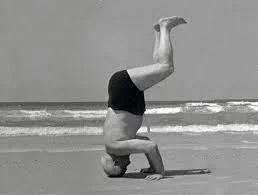Headstand and falling
Moshe practicing the art of falling.
I was one of those people who definitely, absolutely, never in a million years could do a headstand. Until I did.
This series must be done carefully, of course. But it IS possible. Don’t worry, it is very slow, and you will not do anything that looks like a headstand unless and until it feels safe. In fact, the study here is not how to stand on your head. Rather, it is how to balance and fall, over and over. A headstand, Moshe says, is just a moment in the process of falling. Even if you never do a headstand, the experience of balancing and falling is profoundly helpful. One of my clients in her 70s used it to prevent injury when she fell on the ice. You never know when it will come in handy.
(Headstand series from the Amherst training weeks 3 & 4, June, 1981)
Here you practice putting the head on the floor and finding the structural support through the neck. Don’t worry, you can do one movement and rest. Even that will give you good feedback.
Most of us have no idea how to use the head as a “fifth limb.” As you discover where the top of the head actually is, your confidence grows. You play with the tripod position of the head and hands, then you lift one hand and the other to sense the weight shift. Gently roll the head forward and back to discern what “top” means. As you hone your perception, you stand on the toes and lift a knee, then another knee. You’ll be amazed at how quickly confusion transforms into clarity.
Here you lift and drop the feet many times. Then add pressing the feet as you lift the pelvis, which is the beginning of “carping.”
With lots of swinging the legs and rolling up the spine, you become more supple and balanced along your back. Return to finding the top the head as you lift one knee, then the other. Finally, stand on your toes and walk the feet towards the head, then left and right. How is your upside-down balance now?
The ability of the legs to go overhead in a headstand requires access to the anti-gravity muscles along the spine. This extension lesson organizes your back muscles in many many ways. Plus, it’s a useful (and fun!) experience to feel the physics of “when something goes up, something else goes down.”
Here you repeat many variations of finding the top of the head and walking the feet around, with the addition of bringing a knee to an elbow. You will also refine rolling up the spine with the legs overhead, including advanced carping.
This series advances in many small steps so you challenge your nervous system bit by bit. Each new strategy builds on everything learned before. Even if this process feels elusive, keep doing the movements as some variations will be more available than others.
Here you clarify how to use the floor to lift and press the legs, ribs, arms, shoulders, and head, because eventually you will be bringing the legs into the air and how are you going to get them off the floor? Ah, Moshe has an answer for that.
Moshe spent a lot of time on this pattern in his Amherst training. Don’t worry, this is still a gentle lesson because, well, how hard do you have to press to know you’re doing it?
Moshe famously taught David Ben Gurion to do a headstand on the beach in Tel Aviv. To this day, there is a statue of Ben Gurion in a headstand on that beach.



